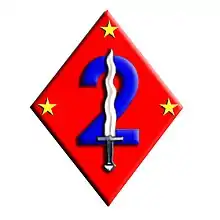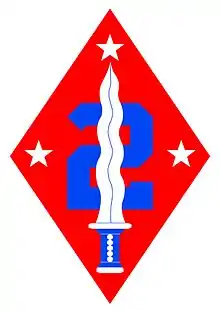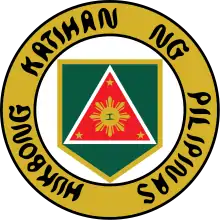2nd Infantry Division (Philippines)
The 2nd Infantry Division, Philippine Army, known officially as the Jungle Fighter Division, is the Philippine Army's primary infantry unit specializing in jungle warfare.
| 2nd Infantry Division | |
|---|---|
 Unit Seal of the 2nd Infantry Division | |
| Active |
|
| Country | |
| Branch | Philippine Army |
| Type | |
| Role | Conventional Warfare, Anti-Guerrilla Operations |
| Size | 3 Brigades |
| Part of | 1st Military District under the Philippine Commonwealth Army (1941-1942) Under the Philippine Army (Since 1976) |
| Garrison/HQ | Camp General Mateo M. Capinpin, Tanay, Rizal |
| Nickname(s) | Jungle Fighter Division |
| Motto(s) | Advocates of Peace. Servants of the People. Defenders of Southern Tagalog. |
| Mascot(s) | Jungle Popoy |
| Anniversaries | March 19 |
| Engagements | World War II * Philippines campaign (1941–1942) * Battle of Bataan (1942) Anti-guerilla operations against the NPA and local criminal elements |
| Decorations | Presidential Streamer Award |
| Website | junglefighterdivision |
| Commanders | |
| Current commander | MGen Greg T. Almerol AFP |
| Notable commanders |
|
| Insignia | |
| Armed Forces Occupational Specialty Insignia |  |
WWII Philippine Army Divisions | |
|---|---|
| Previous | Next |
| 1st Division (PA) | 11th Division (PA) |
History
2nd Regular Division, Philippine Commonwealth Army during World War II under the Japanese Invasion


The 2nd Regular Division, Philippine Commonwealth Army, was activated 6 January 1942, uniting the 4 existing Philippine Constabulary Regiments under one divisional command.[1] Part of these troops were at Camp Murphy (now Camp Emilio Aguinaldo) in Quezon City and part at Fort William McKinley (now Fort Andres Bonifacio) in Taguig, Rizal (now part of Metro Manila). The Armed Forces reorganization acts passed in 1936 led to the decision to militarize Constabulary (Police) officers into organized fighting units. The Constabulary reverted to their original semi-military ("gendarme") structure in 1938. But the need for more armed Filipinos to aid in resisting the rise and possible threat of Japanese military operations in mid-1941 led to the re-establishment of formal military organization of the Constabulary forces. Therefore, the organization of four regiments finally got underway in the early Fall of 1941, and upon activation, each regiment was inducted into the tables of organization and orders of battle for the United States Army Forces in the Far East (USAFFE). The 1st Philippine Constabulary Regiment dates from 15 Oct 1941; the 2nd Regiment from 17 Nov 1941; the 3rd Regiment from 12 Dec 1941; and the 4th Regiment from 29 Dec 1941.
Most of the 1st Regiment and all of the 2nd had been guarding public utilities and other targets of potential sabotage in the Manila metro area. By 31 Dec 1941, the 3rd and newly formed 4th Regiments were on Bataan, or were en route. But after the withdrawal of American troops from Manila (to avoid a battle in the city) the 1st and 2nd Regiments also moved to Bataan. Here they were moved under the umbrella of the new 2nd Division (PC) (Philippine Constabulary) after its activation on 6 January 1942. The 2nd Division commander was BGen. (later MGen.) Guillermo B. Francisco.
The 2nd Division was on Bataan from 6 Jan 1942 to the fall of the peninsula on 9 Apr 1942, aiding the Gen. Douglas MacArthur's USAFFE military forces, against the Imperial Japanese troops led by General Masaharu Homma during the Battle of Bataan in 1942.
Throughout the main battle for the Bataan peninsula, from February to April 1942, Constabulary troops and officers fought side by side with other Philippine Commonwealth and American forces of the USAFFE, attacking and defending against Japanese troops. These battles include the Layac Line, Porac-Guagua Line, Abucay-Mauban Line, Battle of Trail 2, the Battle of the Pockets and the Battle of the Points, before the invasion at Mount Samat on 3 Apr 1942. On that date—Good Friday—Mount Samat fell. On 9 April 1942, the starving defending Fil-American forces, including the 2nd Division, surrendered to the Imperial Japanese Army on Bataan. After the enemy forces organized the surrendered troops into one large group, all Filipinos and Americans began the long walk from Mariveles, Bataan to Camp O'Donnell in Capas, Tarlac. This was the start of the Bataan Death March.[2]
2nd Infantry Division, Philippine Army during the Post-War Era
On 1 February 1970, the 2nd Infantry Brigade (Separate) was activated. Its first headquarters was in Camp Vicente Lim in Canlubang, Calamba City and later, was moved to Barangay Sampaloc, Tanay, Rizal. Camp Capinpin, the present camp, was named after Brigadier General Mateo M. Capinpin, the intrepid commander of the 21st Division, Philippine Army, USAFFE, who rose from the ranks during World War I. It is strategically situated 70 kilometers east of Manila at the foothills of the scenic Sierra Madre Mountains, at an elevation of 1,400 feet above sea level.
On 19 March 1976, the 2nd Infantry Brigade was upgraded and reorganized as the 2nd Infantry Division, Philippine Army, at Camp Mateo Capinpin. Since the reorganization, twenty-five successive Commanders have already led the 2nd Infantry Division.
This expansion from a brigade to a full division became necessary as brigade troops were assigned to combat the Communist rebels and local criminal element operations in Southern Luzon and beyond. These combat engagements were carried out over multiple regions and provinces, including the two regions of Calabarzon and Mimaropa, and the nine major provinces of Rizal, Cavite, Laguna, Batangas, Quezon, Occidental Mindoro, Oriental Mindoro, Marinduque and Palawan. The ongoing Communist insurgencies in the Philippines began in 1969 with the Communist rebel fighters of the New People's Army (NPA), and worsened to include the Communist Party of the Philippines (CPP), the National Democratic Front of the Philippines (NDF-P), and other local criminal elements. Battling these destructive elements, with both military and criminal aspects, hearkens back to the Constabulary roots of the 2nd Division.
In August 2016, President Rodrigo Duterte pulled out the 68th and 74th Infantry Battalion from Southern Luzon and reassigned them to Basilan in order to aid against the Abu Sayyaf Group. The pullout of the 74th Infantry Battalion left the province of Marinduque without a regular military contingent, leaving only the Citizen Armed Force Geographical Unit of the 59th Infantry Battalion to secure the province.
2ID Seal
The 2nd Infantry Division’s emblem inscribes the Command’s banner. It symbolizes the aspiration for peace and tranquility of the Filipino people within the Divisions area of jurisdiction.
RED-COLORED BACKGROUND – the red colored back ground of the diamond signifies courage and bravery.
WHITE-COLORED BAND – the white colored band running at its edge marks the unblemished reputation of the die-hard vanguard of freedom.
THREE YELLOW-COLORED STARS – represents the three major islands of the Philippines (Luzon, Visayas and Mindanao).
DIAMOND SHAPE – the diamond shape connotes the extent of the Division`s areas of operation.
KRIS – superimposed over the number “2” is the “Kris”, a dominant weapon, which represents the unity of the guardian of freedom and independence of the Filipino people. The silver blade implies the dignity of the people.
NUMERICAL FIGURE 2 – the Arabic numerical “2”, located at the center of the diamond, distinguishes itself as the “Second-to-None Hard Hitting Division” of the Army for its combat action against internal or external enemies/threats. The blue-colored number `2` signifies patriotism.
Mission
The current mission of the 2nd Infantry Division is to conduct Focused Military Operations while sustaining support to the Regional Task Force to End Local Communist Armed Conflict (RTF-ELCAC), to decisively defeat the Southern Tagalog Regional Party Committee (STRPC) armed groups and deny their manpower, financial, and logistical resources in order to bring them back to the breaking point of their collapse and eventual end of insurgency in Regions 4A and 4B (except Palawan) that will create a safe and sound environment—both physically and psychologically—conducive for development and commerce.
Lineage of Commanding Officers
- BGen Domingo R Tucay AFP (01 Feb 70 - 01 Apr 70)
- BGen Teodorico R Almuete AFP (01 Apr 70 - 16 Jan 70)
- BGen Juan L Razo AFP (16 Jan 70 - 18 Feb 1972)
- BGen Ramon L Cannu AFP (19 Feb 72 - 17 Sep 79 / 17 Jan 82 - 16 Aug 83)
- BGen Zoshimo C Carlos AFP (18 Sep 79 - 17 Jan 82)
- BGen Roland I Pattugalan AFP (16 Aug 83 - 04 Mar 86)
- BGen Restituto C Padilla AFP (05 Mar 86 - 15 Mar 87)
- BGen Alejandro A Galido AFP (16 Mar 87 - 18 Mar 88)
- BGen Raul T Aquino AFP (26 Mar 88 - 16 Apr 89)
- BGen Javier D Carbonnel AFP (16 Apr 89 - 03 Dec 89)
- BGen Thelmo Y Cunanan AFP (03 Dec 89 - 24 Jan 91)
- BGen Cesar F Fortuno AFP (26 Jan 91 - 25 Mar 92)
- BGen Regino J Lacson AFP (22 Mar 92 - 23 Feb 95)
- BGen Romeo D Lopez AFP (23 Feb 95 - 16 Aug 96)
- BGen Samuel T Dungque AFP (16 Aug 96 - 08 Oct 97)
- BGen Rolando C Bautista AFP (09 Oct 97 - 12 Jan 98)
- MGen Jose S Lachica AFP (12 Jan 98 - 01 Mar 00)
- MGen Roberto P Santiago AFP (06 Mar 00 - 08 Mar 01)
- MGen Jacinto C Ligot AFP (28 Mar 01 - 6 May 02)
- MGen Efren L Abu AFP (6 May 02–30 Jul 03)
- MGen Gabriel M Ledesma AFP (30 Jul 03 - 21 Jan 04)
- MGen Pedro R Cabuay Jr AFP ( 21 Jan 04 - 21 Nov 04)
- MGen Efren P Orbon AFP (24 Nov 04 - 13 Dec 05)
- MGen ALexander B Yano AFP (20 Jan 06 - 03 Aug 06)
- MGen Fernando L Mesa AFP (03 Aug 06 - 11 Sep 07)
- MGen Delfin N Bangit AFP (11 Sep 07 - 8 May 08)
- MGen Roland M Detabali AFP (8 May 08 - 02 Jun 09)
- BGen Florante B Martinez AFP (02 Jun 09 - 23 Jul 09)
- MGen Jorge V Segovia AFP (23 Jul 09 - 30 Jul 10)
- MGen Jessie D Dellosa AFP (30 Jul 10 - 22 Jul 11)
- BGen Nestor A Annonuevo AFP (22 Jul 11 - 23 Aug 11)
- MGen Romulo M Bambao AFP (23 Aug 11 - 21 Jan 12)
- MGen Eduardo D Del Rosario AFP (21 Jan 12 - 22 Nov 12)
- MGen Nonato Alfredo T Peralta Jr AFP (22 Nov 12 - 25 Nov 13)
- MGen Rodelio V Santos AFP (25 Nov 13 - 03 Feb 15)
- MGen Romeo P Gan AFP (03 Feb 15 - 10 Nov 16)
- MGen Rhoderick M Parayno AFP (10 Nov 16 - 03 May19)
- BGen Elias H Escarcha AFP (4 May 19 - 11 Jul 19)
- MGen Arnulfo Marcelo B Burgos Jr AFP (12 July 19 - Present)
1942 Order of Battle
Current
The following are the Brigade units that are under the 2nd Infantry Division.
- 201st Infantry (Kabalikat) Brigade
- 202nd Infantry (Unifier) Brigade
- 203rd Infantry (Bantáy Kapayapaan) Brigade
The following are the Battalion units that are under the 2nd Infantry Division
- 1st Infantry (Always First) Battalion
- 2nd CMO Battalion/Task Force Ugnay
- 4th Infantry (Scorpion) Battalion
- 16th Infantry (Maglilingkód) Battalion
- 59th Infantry (Protector) Battalion
- 68th Infantry (Kaagapay) Battalion
- 74th Infantry (Unbeatable) Battalion
- 76th Infantry (Victrix) Battalion
- 80th Infantry (Steadfast) Battalion
- 85th Infantry (Sandiwà) Battalion
- 92nd Infantry (Tanglaw Diwa) Battalion
2nd Division (PC)
- 1st Constabulary Regiment (PC) (LCol. Irwin Alexander) (?) (Activated 15 Oct 1941)
- 2nd Constabulary Regiment (PC) (Activated 17 Nov 1941)
- 3rd Constabulary Regiment (PC) (Activated 12 Dec 1941)
- 4th Constabulary Regiment (PC) (Activated 29 Dec 1941)
Operations
- The engagements of the military operations against the Imperial Japanese Armed Forces from January 3, 1942, to September 2, 1945, during World War II under the Japanese Occupation.
- Anti-guerrilla operations against the New People's Army.
- Anti-terrorist operations against the Abu Sayyaf operating in their AOR.
- The 2nd Infantry Division was among the forerunners of what is now the 1st Scout Ranger Regiment.
- MGen Delfin Bangit was previously assigned as the Presidents Most Senior Aide-de-camp and is the commanding officer of the Presidential Security Group.
- MGen Pedro Cabouay was former commander of the Intelligence Service AFP and Light Armor Brigade (now Light Armor Division) was an alumnus of the University of Santo Tomas College of Commerce and is a product of the Philippine ROTC System.
- LtGen Alexander Yano, former commander of the 2ID, was previously assigned as Army Chief and later on as AFP Chief of Staff.
- MGen Fernando Mesa is currently serving as the AFP NCR Command's commanding general. Overseeing security measures for the National Capital Region and is also responsible in securing the seat of power of the Philippine Government.
References
- "General Background and miscellaneous correspondence procedures unique to the Philippine Army Records". National Archives. 2016-08-15. Retrieved 2020-01-22.
- "Bataan Death March | Definition, Facts, Aftermath, & Significance". Encyclopedia Britannica. Retrieved 2020-01-22.
